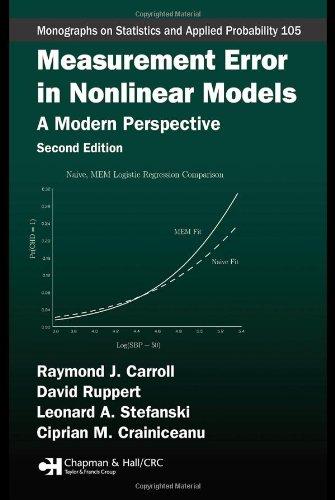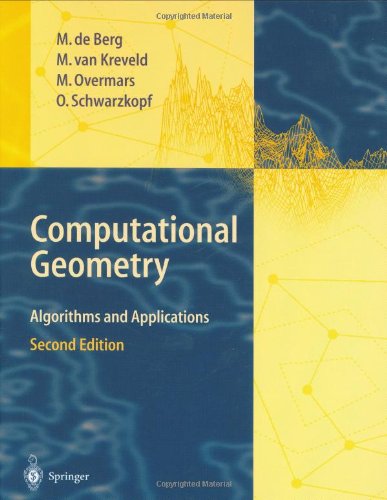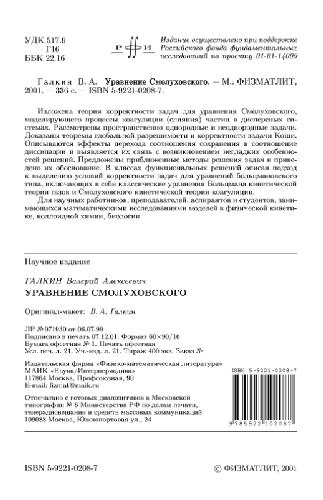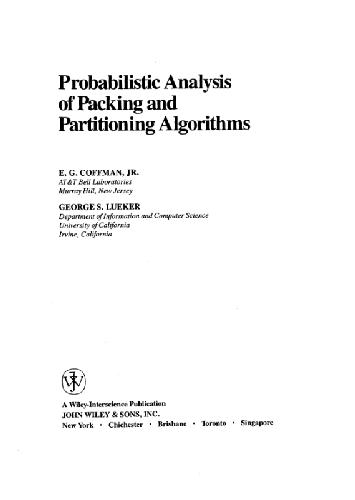Raymond J. Carroll, David Ruppert, Leonard A. Stefanski, Ciprian M. Crainiceanu9781584886334, 1584886331
What’s new in the Second Edition?
· Greatly expanded discussion and applications of Bayesian computation via Markov Chain Monte Carlo techniques
· A new chapter on longitudinal data and mixed models
· A thoroughly revised chapter on nonparametric regression and density estimation
· A totally new chapter on semiparametric regression
· Survival analysis expanded into its own separate chapter
· Completely rewritten chapter on score functions
· Many more examples and illustrative graphs
· Unique data sets compiled and made available online
In addition, the authors expanded the background material in Appendix A and integrated the technical material from chapter appendices into a new Appendix B for convenient navigation. Regardless of your field, if you’re looking for the most extensive discussion and review of measurement error models, then Measurement Error in Nonlinear Models: A Modern Perspective, Second Edition is your ideal source.
Table of contents :
Measurement Error in Nonlinear Models……Page 5
Preface to the First Edition……Page 8
Preface to the Second Edition……Page 12
Guide to Notation……Page 14
Contents……Page 17
Contents……Page 0
A.2 Normal and Lognormal Distributions……Page 27
A.3 Gamma and Inverse-Gamma Distributions……Page 28
A.4.1 Linear Prediction……Page 29
A.4.3 Nonlinear Prediction……Page 31
A.5.2 Maximum Likelihood Estimation……Page 32
A.5.4 Pro¯le Likelihood and Likelihood Ratio Con¯dence Intervals……Page 33
A.5.5 E±cient Score Tests……Page 34
A.6.1 Introduction and Basic Large Sample Theory……Page 35
A.6.2 Sandwich Formula Example: Linear Regression without Measurement Error……Page 37
A.6.3 Sandwich Method and Likelihood-Type Inference……Page 38
A.6.6 Stacking Estimating Equations: Using Prior Estimates of Some Parameters……Page 40
A.7.1 General Ideas……Page 42
A.7.2 Estimation and Inference for QVF Models……Page 43
A.9.1 Introduction……Page 45
A.9.2 Nonlinear Regression without Measurement Error……Page 46
A.9.4 Bootstrapping Logistic Regression Models……Page 48
A.9.5 Bootstrapping Measurement Error Models……Page 49
A.9.6 Bootstrap Con¯dence Intervals……Page 50
B.1 Appendix to Chapter 1: Power in Berkson and Classical Error Models……Page 52
B.2 Appendix to Chapter 3: Linear Regression and Attenuation……Page 53
B.3.1 Standard Errors and Replication……Page 54
B.3.3 Heuristics and Accuracy of the Approximations……Page 58
B.4 Appendix to Chapter 5: SIMEX……Page 59
B.4.1 Simulation Extrapolation Variance Estimation……Page 60
B.4.2 Estimating Equation Approach to Variance Estimation……Page 62
B.5.1 Derivation of the Estimators……Page 66
B.5.2 Asymptotic Distribution Approximations……Page 68
B.6.2 Technical Complements to Distribution Theory for Estimated §uu……Page 73
B.7.1 Monte Carlo Computation of Integrals……Page 74
B.7.2 Linear, Probit, and Logistic Regression……Page 75
B.8.1 Code for Section 9.8.1……Page 76
B.8.2 Code for Section 9.11……Page 77
1.1 The Double/Triple Whammy of Measurement Error……Page 79
1.2 Classical Measurement Error: A Nutrition Example……Page 80
1.3 Measurement Error Examples……Page 81
1.4 Radiation Epidemiology and Berkson Errors……Page 82
1.4.1 The Difference Between Berkson and Classical Errors: How to Gain More Power Without Really Trying……Page 83
1.5 Classical Measurement Error Model Extensions……Page 85
1.6.1 NHANES……Page 87
1.6.2 Nurses’ Health Study……Page 88
1.6.4 Bioassay in a Herbicide Study……Page 89
1.6.6 Coronary Heart Disease and Blood Pressure……Page 90
1.6.8 Blood Pressure and Urinary Sodium Chloride……Page 91
1.7 Checking the Classical Error Model……Page 92
1.8.1 Linear Regression Example……Page 96
1.8.2 Radiation Epidemiology Example……Page 98
Bibliographic Notes……Page 101
2.1 Functional and Structural Models……Page 103
2.2.1 General Approaches: Berkson and Classical Models……Page 104
2.2.2 Is It Berkson or Classical?……Page 105
2.2.3 Berkson Models from Classical……Page 106
2.2.4 Transportability of Models……Page 107
2.2.5 Potential Dangers of Transporting Models……Page 108
2.3 Sources of Data……Page 110
2.4 Is There an Exact” Predictor? What Is Truth?……Page 111
2.5 Differential and Nondifferential Error……Page 114
2.6 Prediction……Page 116
Bibliographic Notes……Page 117
3.2 Bias Caused by Measurement Error……Page 118
3.2.1 Simple Linear Regression with Additive Error……Page 119
3.2.2 Regression Calibration: Classical Error as Berkson Error……Page 121
3.2.3 Simple Linear Regression with Berkson Error……Page 122
3.2.4 Simple Linear Regression, More Complex Error Structure……Page 123
3.2.5 Summary of Simple Linear Regression……Page 126
3.3.1 Multiple Regression: Single Covariate Measured with Error……Page 129
3.3.2 Multiple Covariates Measured with Error……Page 130
3.4.1 Method of Moments……Page 132
3.4.2 Orthogonal Regression……Page 134
3.5 Bias Versus Variance……Page 137
3.5.1 Theoretical Bias-Variance Tradeoff Calculations……Page 138
3.6 Attenuation in General Problems……Page 140
Bibliographic Notes……Page 141
4.1 Overview……Page 142
4.3 NHANES Example……Page 143
4.4.2 Best Linear Approximations Using Replicate Data……Page 147
4.5 Multiplicative Measurement Error……Page 149
4.5.1 Should Predictors Be Transformed?……Page 150
4.5.2 Lognormal X and U……Page 151
4.5.3 Linear Regression……Page 154
4.5.4 Additive and Multiplicative Error……Page 155
4.7 Expanded Regression Calibration Models……Page 156
4.7.1 The Expanded Approximation Defined……Page 158
4.7.2 Implementation……Page 160
4.7.3 Bioassay Data……Page 162
4.8.2 Logistic Regression……Page 167
4.8.3 Loglinear Mean Models……Page 170
4.9.2 Quadratic Regression with Homoscedastic Regression Calibration……Page 171
Bibliographic Notes and Software……Page 172
5.1 Overview……Page 174
5.2.1 SIMEX in Simple Linear Regression……Page 175
5.3.1 Simulation and Extrapolation Steps……Page 177
5.3.2 Extrapolant Function Considerations……Page 185
5.3.3 SIMEX Standard Errors……Page 187
5.3.4 Extensions and Refinements……Page 188
5.4.1 Framingham Heart Study……Page 189
5.4.2 Single Covariate Measured with Error……Page 190
5.4.3 Multiple Covariates Measured with Error……Page 195
5.5.1 Multiple Linear Regression……Page 197
5.5.3 Quadratic Mean Models……Page 199
5.6.1 Mixture of Berkson and Classical Error……Page 200
5.6.2 Misclassi¯cation SIMEX……Page 202
5.6.3 Checking Structural Model Robustness via Remeasurement……Page 203
Bibliographic Notes……Page 205
6.1 Overview……Page 206
6.1.1 A Note on Notation……Page 207
6.2.1 Instrumental Variables via Differentiation……Page 208
6.2.2 Simple Linear Regression with One Instrument……Page 209
6.2.3 Linear Regression with Multiple Instruments……Page 211
6.3.1 IV Assumptions……Page 214
6.3.2 Mean and Variance Function Models……Page 215
6.3.3 First Regression Calibration IV Algorithm……Page 216
6.4 Adjusted Score Method……Page 217
6.5.1 Framingham Data……Page 220
6.6.1 Hybrid Classical and Regression Calibration……Page 222
6.6.2 Error Model Approaches……Page 224
Bibliographic Notes……Page 225
7.1 Overview……Page 227
7.2.1 Linear Regression Corrected and Conditional Scores……Page 228
7.2.2 Logistic Regression Corrected and Conditional Scores……Page 233
7.2.3 Framingham Data Example……Page 235
7.3.1 Conditional Score Basic Theory……Page 238
7.3.2 Conditional Scores for Basic Models……Page 240
7.3.3 Conditional Scores for More Complicated Models……Page 242
7.4 Corrected Score Functions……Page 245
7.4.2 Monte Carlo Corrected Scores……Page 246
7.4.3 Some Exact Corrected Scores……Page 248
7.4.5 Corrected Scores with Replicate Measurements……Page 249
7.5 Computation and Asymptotic Approximations……Page 250
7.5.1 Known Measurement Error Variance……Page 251
7.5.2 Estimated Measurement Error Variance……Page 252
7.6 Comparison of Conditional and Corrected Scores……Page 253
7.7 Bibliographic Notes……Page 254
8.1 Introduction……Page 256
8.1.1 Step 1: The Likelihood If X Were Observable……Page 258
8.2 Steps 2 and 3: Constructing Likelihoods……Page 259
8.2.1 The Discrete Case……Page 260
8.2.2 Likelihood Construction for General Error Models……Page 261
8.2.3 The Berkson Model……Page 263
8.2.4 Error Model Choice……Page 264
8.4 Cervical Cancer and Herpes……Page 265
8.5 Framingham Data……Page 267
8.6 Nevada Test Site Reanalysis……Page 268
8.6.1 Regression Calibration Implementation……Page 270
8.6.2 Maximum Likelihood Implementation……Page 271
8.7 Bronchitis Example……Page 272
8.7.1 Calculating the Likelihood……Page 273
8.7.3 Simulation Study and Maximum Likelihood……Page 274
8.8 Quasilikelihood and Variance Function Models……Page 276
8.8.1 Details of Step 3 for QVF Models……Page 277
Bibliographic Notes……Page 278
9.1.1 Problem Formulation……Page 279
9.1.2 Posterior Inference……Page 281
9.1.3 Bayesian Functional and Structural Models……Page 282
9.2 The Gibbs Sampler……Page 283
9.3 Metropolis{Hastings Algorithm……Page 285
9.4 Linear Regression……Page 287
9.4.1 Example……Page 290
9.5.1 A General Model……Page 293
9.5.2 Polynomial Regression……Page 294
9.5.3 Multiplicative Error……Page 295
9.5.4 Segmented Regression……Page 296
9.6 Logistic Regression……Page 297
9.7.1 Nonlinear Regression with Berkson Errors……Page 299
9.7.2 Logistic Regression with Berkson Errors……Page 301
9.7.3 Bronchitis Data……Page 302
9.8 Automatic Implementation……Page 304
9.8.1 Implementation and Simulations in WinBUGS……Page 305
9.8.2 More Complex Models……Page 308
9.9 Cervical Cancer and Herpes……Page 309
9.10 Framingham Data……Page 311
9.11 OPEN Data: A Variance Components Model……Page 312
Bibliographic Notes……Page 314
10.1.1 Simple Linear Regression, Normally Distributed X……Page 316
10.1.2 Analysis of Covariance……Page 319
10.1.4 Summary of Major Results……Page 321
10.2 The Regression Calibration Approximation……Page 322
10.2.3 Testing H0 : Btx, Bt z)t = 0……Page 323
10.4 Hypotheses about Subvectors of Bx and Bz……Page 324
10.4.1 Illustration: Framingham Data……Page 325
10.5 Efficient Score Tests of H0 : Bx = 0……Page 326
10.5.1 Generalized Score Tests……Page 327
Bibliographic Notes……Page 330
11.1.1 Simple Linear Mixed Models……Page 331
11.1.2 The General Linear Mixed Model……Page 332
11.1.4 The Generalized Linear Mixed Model……Page 333
11.2.1 The Variance Components Model Revisited……Page 334
11.2.3 Some Simple Examples……Page 335
11.3 A Bias-Corrected Estimator……Page 337
11.5 Regression Calibration for GLMMs……Page 339
11.7 Joint Modeling……Page 340
11.8.1 Models with Random E®ects Multiplied by X……Page 341
11.8.3 Inducing a True-Data Model from a Standard Observed Data Model……Page 342
11.8.4 Autoregressive Models in Longitudinal Data……Page 343
11.9 Example: The CHOICE Study……Page 344
11.9.2 Naive Replication and Sensitivity……Page 345
11.9.3 Accounting for Biological Variability……Page 346
Bibliographic Notes……Page 348
12.1.1 The Problem……Page 350
12.1.3 Methodology……Page 351
12.1.4 Properties of Deconvolution Methods……Page 352
12.1.5 Is It Possible to Estimate the Bandwidth?……Page 353
12.1.6 Parametric Deconvolution……Page 355
12.1.7 Estimating Distribution Functions……Page 358
12.1.8 Optimal Score Tests……Page 359
12.1.9 Framingham Data……Page 360
12.1.10 NHANES Data……Page 361
12.1.11 Bayesian Density Estimation by Normal Mixtures……Page 362
12.2.1 Local-Polynomial, Kernel-Weighted Regression……Page 364
12.2.2 Splines……Page 365
12.2.3 QVF and Likelihood Models……Page 366
12.2.4 SIMEX for Nonparametric Regression……Page 367
12.2.6 Structural Splines……Page 368
12.2.7 Taylex and Other Methods……Page 369
12.3 Baseline Change Example……Page 370
12.3.1 Discussion of the Baseline Change Controls Data……Page 372
Bibliographic Notes……Page 373
13.2 Additive Models……Page 374
13.3 MCMC for Additive Spline Models……Page 375
13.4 Monte Carlo EM-Algorithm……Page 376
13.4.3 The Algorithm……Page 377
13.5 Simulation with Classical Errors……Page 380
13.6 Simulation with Berkson Errors……Page 382
13.7 Semiparametrics: X Modeled Parametrically……Page 383
13.8.1 Deconvolution Methods……Page 385
13.8.2 Models Linear in Functions of X……Page 386
13.8.3 Linear Logistic Regression with Replicates……Page 387
13.8.4 Doubly Robust Parametric Modeling……Page 388
Bibliographic Notes……Page 389
14.1 Notation and Assumptions……Page 390
14.2 Induced Hazard Function……Page 391
14.3.1 Methodology and Asymptotic Properties……Page 392
14.3.2 Risk Set Calibration……Page 393
14.4 SIMEX for Survival Analysis……Page 394
14.5 Chronic Kidney Disease Progression……Page 395
14.5.1 Regression Calibration for CKD Progression……Page 396
14.5.2 SIMEX for CKD Progression……Page 397
14.6 Semi and Nonparametric Methods……Page 400
14.6.1 Nonparametric Estimation with Validation Data……Page 401
14.6.2 Nonparametric Estimation with Replicated Data……Page 403
14.6.3 Likelihood Estimation……Page 404
14.7 Likelihood Inference for Frailty Models……Page 407
Bibliographic Notes……Page 408
15.1 Response Error and Linear Regression……Page 410
15.2.1 Biased Responses……Page 414
15.2.2 Response Error in Heteroscedastic Regression……Page 415
15.3.1 The Impact of Response Misclassification……Page 416
15.3.2 Correcting for Response Misclassification……Page 418
15.4.1 General Likelihood Theory and Surrogates……Page 424
15.4.2 Validation Data……Page 425
15.5.1 Likelihood of the Validation Data……Page 426
15.6.1 Simple Random Sampling……Page 427
15.6.2 Other Types of Sampling……Page 428
Bibliographic Notes……Page 429
References……Page 430







Reviews
There are no reviews yet.